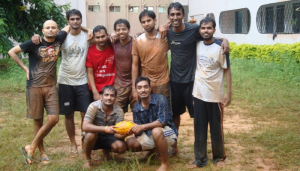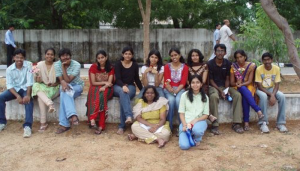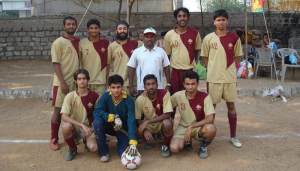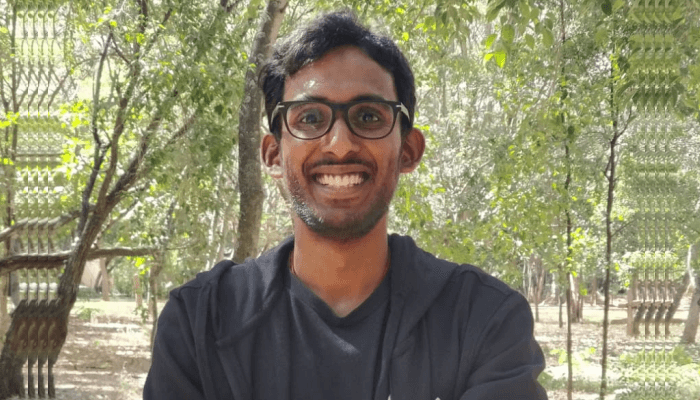Rahul Saladi did his BTech and MS in Computer Science at IIITH from 2004-2011. He currently works as an Assistant Professor at IISc, Bangalore. In a telephonic conversation, he talks at length about the side to research that rarely receives much attention and claims that the alma mater gave him his life – a wife, friends like family, a research career, sports and yoga. Read on to find out more.
If you’ve grown up in the ‘80s and the ‘90s, you will be all too familiar with the puzzle books that were routinely found in bookstores then. Primary school-going Rahul had this peculiar penchant for immersing himself in such books and solving puzzle after puzzle with gusto. As he grew older, he was introduced to Competition Success Review, a magazine intended for prepping aspirants to the Civil Services exams and other Banking Recruitment exams. “Of course, I used to ignore all the other parts such as English and dive straight to the Math section which was the only thing of interest to me,” recounts Rahul. Such was his fascination for numbers that he not only used to mentally multiply 3-digit numbers for fun but also spend Summer holidays solving all the Math problems in advance from the text book meant for the next academic year. “Of all the subjects I learnt at school, it was only Maths that really fascinated me.”
How It Began
Sadly, the fun part of it fizzled out and his natural proclivity toward Math took a backseat when he was made to prep for entrance exams into the IITs. Born in Gwalior, brought up and raised across many Indian states such as Andhra Pradesh, Assam and Gujarat, Rahul came to Hyderabad for coaching. It was incidentally the city he frequented every Summer to visit his grandmother. When he eventually signed up for a BTech degree in Computer Science at the International Institute of Information Technology (IIITH), Rahul was none the wiser. “We didn’t have much exposure to Computer Science then and didn’t know what we were getting into. And to be brutally honest, I wasn’t even very keen on it. I mean, I was serious enough to get good grades but there was definitely no burning passion happening back then!,” he laughs. For him, life then revolved around music (singing in competitions), the company of good friends (hanging out for hours on end at the NBH mess, due to which he was also known as ‘NBH Rahul’), and endless hours of playing cricket and football.

Finding Meaning
In the third year, a seemingly innocuous problem for a semester project turned into a life defining moment for Rahul. “Prof. Prosenjit Gupta taught us a course on Algorithms. And it was a problem related to detection of collision among moving objects,” explains Rahul. With a single mind-wracking problem and the license of an entire semester to solve it in, he rediscovered his forgotten love for solving puzzles. When Rahul was informed that a career could be made out of a discipline such as this, which was akin to puzzle-solving, known as Theoretical Computer Science, his perspective about Computer Science itself was altered. He knew there was no looking back. Interestingly enough, that problem remains unsolved till date. Despite objections from immediate family, Rahul converted his BTech into a Dual Degree programme. “It helped that my future wife, Haritha too was pursuing a Dual Degree, making my decision easier. In hindsight, both projects turned out to be a success!,” he quips cheekily.

Campus Rumpus
Apart from the indelible memories of interactions with Prof. Gupta and Prof. Rajan with whom he collaborated on for projects in Computational Geometry and Spatial Informatics respectively, Rahul speaks fondly of the faith shown in him by Profs. Kishore and Kamal too. There was also Kamlakar, the Sports In-charge who often reached out as a friend to Rahul, “taking care of my mood swings and love-hate relationship with football”. From being an extremely shy kid in the first few years on campus, Rahul grew more extroverted thanks to the close-knit friends he made. Research and the ensuing focus that it required, formed only a small part of life on campus. Among his ‘achievements’, Rahul lists winning a prize for singing – after 14 unsuccessful attempts where he was booed off stage mercilessly – as one of them. Another is for bowling the maximum number of wides in an over (11, to be precise!). Alongside these shenanigans, he was the Vayu house captain, later captain of the institute’s football team, and was also awarded the Best Football Player of 2008. Serendipitously, the downside to all the on-field cricketing and football action which brought on a multitude of injuries, also drew Rahul towards yoga. What began as long, deep conversations with Yogacharya Vinayak Joshi later led to regular practice sessions with Sushant Kishore, who was then a Research Assistant at LTRC and a keen proponent of yoga. “During my PhD days, I lost touch with yoga but I’ve gotten back to it. It forms a very important part of my life and I owe IIITH for having introduced me to it,” says Rahul. In terms of food, for a majority of alumni, the most sought-after joint on campus has been the Yuktahaar mess. Rahul is no different. Calling it, “the most underrated place”, he reveals that he still seeks a meal there whenever he comes visiting his alma mater.

After IIITH
A brief stint at Amazon, Hyderabad, towards the culmination of his Masters degree made Rahul realise he wasn’t cut out for a job in industry. Following Prof. Gupta’s advice, he went to the University of Minnesota for a PhD under Prof. Ravi Janardan. “It was not a difficult choice to make since Prof. Janardan had been the advisor to Prof. Gupta himself! At the same time, there were two other students from IIIT-H who came along for a PhD under Prof. Janardan. Prof. Gupta inspired so many of us to pursue a career in Theoretical Computer Science,” says Rahul wistfully. The focus of Rahul’s research was on range-aggregate queries. To a lay person, that would mean a query problem where the user is not interested in entire data but just a small portion of it and wants an informative summary of that portion. Such queries can help efficiently answer diverse questions such as for a tourist in Bengaluru City who is trying to locate the nearest top rated hotels on his smartphone, or providing relevant criteria for a geologist who is deciding if a particular region in Telangana was affected by forest fires. After a successful stint at Minnesota, Rahul went on to pursue a Postdoc at University of Illinois, Urbana Champaign. The highlight of his research in the US was the publication of two solo author papers which led to his establishment as an independent researcher.
On Research And Its Challenges
For someone who wouldn’t dream of a life without research, he however offers pragmatic advice to others who may wish to follow a similar career path. Drawing a parallel from cricket like a true sportsperson, he emphasizes the need to openly share and discuss research struggles from personal experiences. “For instance, in cricket we all hear about the struggle each player goes through before and after reaching the highest level. But I hardly get to hear such stories in research. Typically, we only hear about the accolades and scientific results being celebrated, and usually not the researcher’s journey itself, giving an impression to everyone else that they must have either been born special or faced no challenge(s) on the way. Knowing these stories would have prepared me better.”
Calling the research process an isolating one that presents a unique set of challenges to every researcher depending on the field of study, the lab culture and the country where it is undertaken, Rahul says that he faced his own when he had to write his solo author papers.
According to him, the initial challenge is coming up with a set of problems that not only interest the research community but also where you might have a fair chance of cracking them. “The cycle of spending long hours and months to come up with potential ideas, which don’t work most of the time(!) to discovering bugs in your own solutions can be disheartening”. The other challenge begins when the problem has been successfully solved and one needs to get down to writing the paper. Often times, the researcher plays a dual role of being the writer and an ‘external’ critic of the write-up. “Finally, you might have to face the cycle of rejections, pick yourself up and improve the paper by going through the above drill again. One of my papers had to go through four such cycles. This whole process had an impact on my overall health. So, if there’s any advice I would give, it would be this: Collaborate and collaborate extensively!”.
Rahul likes to draw a parallel with the experience of watching a movie vs. making one. He says that while watching a movie is entertaining and fun, making it involves a fair share of challenges. “Similarly, in this field of research, while it’s fun to view and appreciate someone else’s solution to a problem, it can be very challenging to come up with one. Plus, while working on a problem, one can never ‘switch off’ and unwind. In that sense, there is a constant drain on your energy and it can get exhausting!”
Algorithmic Sports
Currently as Assistant Prof at the Indian Institute of Science in Bangalore, Rahul comes up with novel and fun ways to hold the attention of his class. “I enjoy the experience of teaching. For me, fun problems are a good way to introduce research to students. In fact, there is a conference called ‘FUN with Algorithms’. The next generation kids will be taught algorithms in high-school itself and I hope we will teach them in a fun manner”. As a sports afficionado himself, it’s not hard to see why he’s keen on introducing sports to teach algorithms. “The conventional sorting algorithms on a computer assume that swapping two data elements can happen in constant time. But let’s say we conduct a ‘sorting’ competition on a sports field with two teams of 100 kids each. Each kid can be given a ‘Bib’ with a number on it and they will have to sort or arrange themselves in increasing order of bib numbers in the fastest possible time. This poses interesting problems since unlike on a computer, swapping on the field depends on how far apart the players are. Plus, each kid has limited stamina whereas data inside a computer can be made to move around any number of times. Also, the kids can perform actions in parallel. Someday, I hope to see an interbatch tournament on ‘Sorting’ at IIITH. It will be interesting to see new algorithms and strategies being invented by students to play it.”



Next post